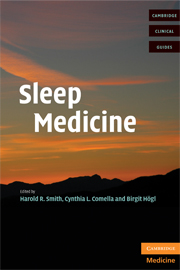Book contents
- Frontmatter
- Contents
- List of contributors
- Foreword
- SECTION 1 NORMAL SLEEP
- SECTION 2 SLEEP DISORDERS
- 3 Parasomnias
- 4 Circadian rhythm disorders
- 5 Excessive somnolence disorders
- 6 Insomnias
- 7 Restless legs syndrome and periodic limb movement disorder
- 8 Sleep apnea (central and obstructive)
- SECTION 3 SLEEP IN SPECIALTY AREAS
- Index
- References
6 - Insomnias
from SECTION 2 - SLEEP DISORDERS
Published online by Cambridge University Press: 08 August 2009
- Frontmatter
- Contents
- List of contributors
- Foreword
- SECTION 1 NORMAL SLEEP
- SECTION 2 SLEEP DISORDERS
- 3 Parasomnias
- 4 Circadian rhythm disorders
- 5 Excessive somnolence disorders
- 6 Insomnias
- 7 Restless legs syndrome and periodic limb movement disorder
- 8 Sleep apnea (central and obstructive)
- SECTION 3 SLEEP IN SPECIALTY AREAS
- Index
- References
Summary
Introduction
Insomnia is one of the most common complaints seen in medicine. Incidence and prevalence estimates vary slightly depending on the methodology, but commonly cited figures are that approximately one-third of Americans have symptoms of acute or intermittent insomnia, and that approximately 10% have chronic insomnia. Over the past several decades, there have been great strides in understanding the pathophysiology of insomnia as well as documenting the efficacy of pharmacologic and nonpharmacologic treatments. There are now sufficient data to allow for meta-analyses to be conducted in insomnia, which help compare effect sizes across studies. This chapter provides an overview of the development of insomnia, information required to make a diagnosis of insomnia, the various recognized insomnia diagnoses, and the pharmacologic, cognitive, and behavioral treatments available.
Pathophysiology of the insomnias
As with certain other sleep disorders, there are cases where insomnia is thought to be a primary condition, times when it is thought to have come about entirely secondary to a medical or psychiatric condition, and times when it may be comorbid with other significant illnesses. There are many theories for the development of insomnia itself, including theories relying on cognitive styles, psychiatric vulnerabilities, and physiological sensitivity or over-reactivity. In 1986 Spielman proposed a particularly useful model of the development of chronic insomnia that allows for multiple etiologies – the “3 P model.”
Spielman's model assumes that certain individuals have a predisposition (the first P) to develop insomnia.
Keywords
- Type
- Chapter
- Information
- Sleep Medicine , pp. 97 - 112Publisher: Cambridge University PressPrint publication year: 2008
References
- 1
- Cited by



